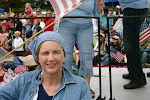Peace and Freedom Party Opposes Top-Two Election System
by Lyn Jensen
Every election season brings
complaints about lack of choice--concerning how America is often described as
having a two-party system that shuts out alternate political views. In California that’s been especially true since the
state adopted a top-two system in 2010. No matter how many candidates qualify
for statewide and legislative primaries, by law voters have only two choices left
by the time of the general election, and those two choices are sometimes between
either two Republicans or two Democrats, nobody else.
Despite this legal barrier to representation, California
actually has six ballot-qualified parties, and the hard-left socialist-leaning Peace
and Freedom Party has been offering voters an alternative since it splintered
from the Democratic Party during the 1967-1968 election cycle. Voters registered
as Peace and Freedom Party members in Los Angeles County number around 34,298,
roughly the same as the population of Manhattan Beach. According to the
California Secretary of State, the party has 96,803 registered voters
statewide, roughly the population of Westminster in Orange County.
California’s other
ballot-qualified parties include the hard-left Greens and the hard-right
Libertarian and American Independent parties. C. T. Weber, a former Peace and
Freedom candidate for governor, provided a joint statement regarding all four
parties’ opposition to the top-two system. Regardless of ideology all four
complain the system has made it harder and more expensive for small parties to
qualify candidates, either by paying filing fees or collecting signatures.
Candidates for statewide office need to collect at least 7,000 valid signatures
in lieu of a filing fee—making the collection of signatures, if hiring people
to collect those 7,000 valid signatures, more expensive than a filing fee—with
no assurance of ever representing the party on the general election ballot.
Today the far-left socialist-leaning wing of the Democratic Party is sometimes called the “Sanders wing” or the “Bernie wing” because much of that wing consists of vociferous supporters of independent socialist senator and Democratic presidential candidate Bernie Sanders. Back in the 1960s, the Peace and Freedom Party provided a similar alternative for socialist-leaning dissidents within the Democratic left.
Kevin Aken, South State
Organizer, helped start the Peace and Freedom Party in 1967 and was a delegate
to its first convention. He complained about the 2020 election in an e-mail to this writer, “Due to how the Top Two laws work, we will have
no candidates at all on the November ballot except our nominees for President
and Vice President (Gloria La Riva of San Francisco and Sunil Freeman of
Maryland). This is sadly normal under Top Two, and was one of the
(unspoken) goals of the proponents.”
Aken's e-mail message added, regarding the difficulty of third parties to work within the current American system, “We are not
presently on any other state ballots, though our presidential ticket is on
about 14 state ballots under various party names (Peace and Freedom, Liberty
Union, Party for Socialism and Liberation, and Independent). Many states
do not allow parties to qualify, the individual candidates must qualify.
Some states do not have party registration.”
In the same e-mail exchange, Aken recalled how the party splintered off amid the bitter political divisiveness of the 1960s, “Some anti-war and anti-racist Democrats, with some left independents, decided that since the Democratic Party leaders made very sure that no anti-war Democrat could win a primary for even State Assembly, their only option was to seek an independent ballot line for anti-war and anti-racist candidates.”
“In 1974 the Peace and Freedom Party shed its Libertarian members, formally describing itself as socialist and feminist,” Aken continued, adding, “Ever since, it has been the largest socialist organization in the country. Members of many left groups in California register to vote in the Peace and Freedom Party, and some of our candidates are members of various other left groups.”
In response to the party being virtually shut out under the top-two system, Weber has worked to find one or more California legislators to sponsor a proposal for “party representatives” to be non-voting members of the state legislature. Modeled on the non-voting members of congress who represent the District of Columbia and US territories, these representatives would represent the interests of their party as opposed to the interests of a particular legislative district. They would be able to introduce legislation, participate in committees, and participate in debates.
Weber elaborated on this approach via an e-mail exchange with this writer, “Under the current rules, these [third-party] voters can never have their views expressed in the legislative chambers . . . The four alternative parties each receive a high enough percentage of votes to have seats in the State Legislature,” were a parliamentary system were in place, the system used in most democracies around the world.
Weber further stated, “Eventually it is our hope that the legislature will put a proposition on the ballot that if passed would change the constitution in a way that voters would be provided more choices in the general election.”
Look forward to Peace and Freedom Party positions on California ballot propositions that qualify for the 2022 election, and other information, on the party’s website: http://www.peaceandfreedom.us/home/

